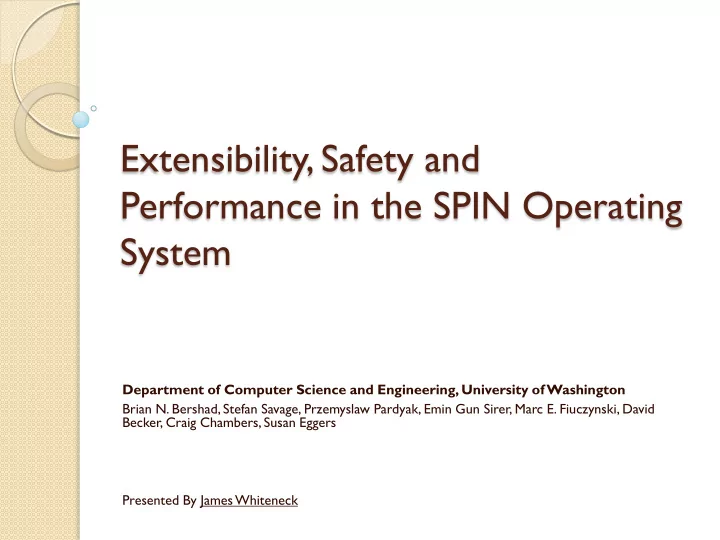

Extensibility, Safety and Performance in the SPIN Operating System Department of Computer Science and Engineering, University of Washington Brian N. Bershad, Stefan Savage, Przemyslaw Pardyak, Emin Gun Sirer, Marc E. Fiuczynski, David Becker, Craig Chambers, Susan Eggers Presented By James Whiteneck
Outline Overview Related Work Motivation Goals SPIN ◦ Architecture (Domains and Extensions) ◦ Core Services (Memory and Thread Management) ◦ Performance Conclusion
Overview SPIN is an extensible OS that allows applications to alter the OS Executed in kernels virtual address space Extensions are written in a type safe language Dynamically linked into existing OS kernel Provides ability to alter core services
Related Work Hydra ◦ Allows applications to manage resources through kernel (high overhead) Microkernels ◦ Extendible (high overhead) RPCs ◦ L3 (high overhead, 100x as much as PC) Software-Based Fault Isolation ◦ Not application specific
Motivation Operating Systems are complex ◦ Not easy to change Want: System that can be dynamically changed to suit specific applications ◦ Safe, easy to use, good performance Image taken from Language Support for Extensible Operating Systems talk. Link: http://www-spin.cs.washington.edu/papers/talks/wcs96.ps
Operating System Structures Monolithic Microkernel Extensible User Level User Level User OS Level Kernel Kernel OS Microkernel Hardware Hardware Hardware
SPIN Image taken from Language Support for Extensible Operating Systems talk. Link: http://www-spin.cs.washington.edu/papers/talks/wcs96.ps
Goals Co-location: extensions are linked directly into kernel ◦ Reduces cost of sharing data Enforced modularity: Compiler enforced boundaries Protection domains: kernel interfaces ◦ Isolate failures and provide cheap context switches ◦ Safely exposing kernel interfaces Dynamic Call Binding: ◦ Events trigger extensions Page faults, threads
SPIN - Architecture Software to safely combine system and application code Implemented in Modula-3 ◦ Safety Defined in two models ◦ Protections Controls access to resources through capabilities ◦ Extensions Defined in terms of events and handlers
Protection Domains Capabilities: is a reference (pointer) to a system object, interface, or collection of interfaces ◦ Protection provided by compiler ◦ Can’t be changed Protection is at the language level, not in virtual memory
Extensions Extension model provides controlled communication between extensions (events and event handlers) and system Event ◦ Message that announces a change in system state or requests a service Event handler ◦ Procedure that receives messages from events Events sent through central dispatcher
SPIN – Core Services Memory Management ◦ Three service interfaces Physical Address Physical page allocation and use Virtual Address Capability allocation Translation Mappings between physical and virtual addresses
SPIN – Core Services Thread Management ◦ Strands Similar to threads No state in kernel ◦ Set of events and event handlers ◦ Interfaces provide scheduling, concurrency, synchronization Application specific
SPIN – Core Services Trust ◦ SPIN trusts core services Required to mediate access to resources, applications, and extensions ◦ Extension failures only affect their own extension
SPIN - Performance OS Model Comparisons ◦ SPIN v0.4 ◦ DEC OSF/1 v2.1 (monolithic) ◦ MACH v3.0 (microkernel) Compared ◦ System Size ◦ Microbenchmarks ◦ Networking ◦ End-to-end Performance
845, way off the page Performance - Microbenchmarks Protected Communication 120 100 Microseconds 80 60 DEC OSF/1 40 Mach SPIN 20 0 Protected in-kernel System call Cross-address call space call Operation Operation DEC OSF/1 Mach SPIN Protected in-kernel call n/a n/a 0.13 System call 5 7 4 Cross-address space call 845 104 89
1230, also way off the page Performance - Microbenchmarks Thread Management 400 350 300 Microseconds 250 200 Fork-Join 150 Ping-Pong 100 50 0 kernel user kernel user kernel layered integrated DEC OSF/1 Mach SPIN OS - Operation Operation DEC OSF/1 Mach SPIN kernel user kernel user kernel layered integrated Fork-Join 198 1230 101 338 22 262 111 Ping-Pong 21 264 71 115 17 159 85
Performance - Microbenchmarks Virtual Memory 2000 1792 1800 1600 1400 Microseconds 1200 1041 1016 1000 DEC OSF/1 819 Mach 800 SPIN 608 600 415 382 351 400 329 302 260 213 214 185 200 106 45 39 29 29 16 7 0 0 2 0 Dirty Fault Trap Prot1 Prot100 Unprot100 Appel1 Appel2 Operation
Other T ests Networking ◦ Measured round trip latency and bandwidth ◦ SPIN application code executes at kernel level Low latency access to both device and data End-to-end ◦ Measured number of clients serviced by a networked video server SPIN allowed same number of clients for less CPU
Conclusion An extensible OS can achieve good performance without compromising safety Able to provide a customizable system using a base set of core services to build upon Future OS should take advantage of compiler safety and support for programming languages.
Recommend
More recommend